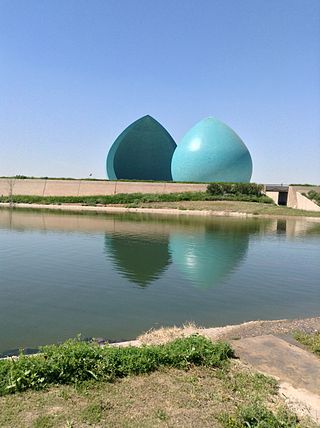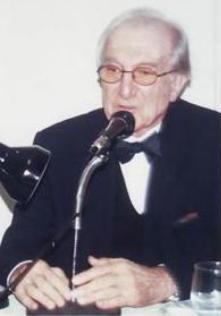
Basra is a city in southern Iraq located on the Shatt al-Arab in the Arabian Peninsula. It had an estimated population of 1.4 million in 2018. Basra is also Iraq's main port, although it does not have deep water access, which is handled at the port of Umm Qasr. However, there is ongoing construction of Grand Faw Port on the coast of Basra, which is considered a national project for Iraq and will become one of the largest ports in the world and the largest in the Middle East, in addition, the port will strengthen Iraq’s geopolitical position in the region and the world. Furthermore, Iraq is planning to establish a large naval base in the Faw peninsula.

Antarah ibn Shaddad al-Absi, also known as ʿAntar, was a pre-Islamic Arab knight and poet, famous for both his poetry and his adventurous life. His chief poem forms part of the Mu'allaqāt, the collection of seven "hanging odes" legendarily said to have been suspended in the Kaaba. The account of his life forms the basis of a long and extravagant romance.

The Green Zone is the most common name for the International Zone of Baghdad. It was a 10-square-kilometer (3.9 sq mi) area in the Karkh district of central Baghdad, Iraq, that was the governmental center of the Coalition Provisional Authority during the occupation of Iraq after the American-led 2003 invasion and remains the center of the international presence in the city. Its official name beginning under the Iraqi Interim Government was the International Zone, though Green Zone remains the most commonly used term. The contrasting Red Zone refers to parts of Baghdad immediately outside the perimeter, but was also loosely applied to all unsecured areas outside the off-site military posts. Both terms originated as military designations.
Ahmed Al Safi is an Iraqi sculptor and painter.

Ismail Fatah Al-Turk was an Iraqi painter and sculptor born in Basra, Iraq, noted for his abstract art, monumental sculpture, and public works and as part of the Baghdad Modern Art Group, which fostered a sense of national identity. His monument, al-Shaheed Monument is the most iconic public monument in Baghdad.

Martyr's Monument, also known as the Martyr's Memorial, is a monument designed by Iraqi sculptor Ismail Fatah Al Turk and situated in the Iraqi capital, Baghdad. It was originally dedicated to the Iraqi soldiers who died in the Iran–Iraq War, and has since grown to become generally considered to be a commemoration of all Iraqi martyrs.

The Monument to the Unknown Soldier is a monument in central Baghdad built by Italian architect Marcello D'Olivo based on a concept by Iraqi sculptor Khaled al-Rahal and constructed between 1979 and 1982. It was dedicated to the martyrs of the Iran–Iraq War. In 1986 the national square of Iraq, Great Celebrations square, was built near the monument, and two other monuments were built close to the square in memory of the martyrs. In 1983, the Al-Shaheed Monument on the River, was opened and in 1989 the newly built Victory Arch became the entrances to the square. The Unknown Soldier's Monument represents a traditional shield (dira¹a) dropping from the dying grasp of an Iraqi warrior. The monument also houses an underground museum.
Fadhil Al Azzawi is an Iraqi writer highly respected in the Arab world, as he has published ten volumes of poetry, six novels, three books of criticism and memoir, and several translations of German literary works. He participated in Iraq's avant-garde Sixties Generation, and his early controversial work was lauded with great enthusiasm.

Badr Shakir al Sayyab was an Iraqi poet who is considered one of the most influential Arab poets of all time. His works have been translated into more than 10 languages including English, Persian, Somali and Urdu.

Iraqi literature or Mesopotamian literature dates back to Sumerian times, which constitutes the earliest known corpus of recorded literature, including the religious writings and other traditional stories maintained by the Sumerian civilization and largely preserved by the later Akkadian and Babylonian empire. Mesopotamian civilization flourished as a result of the mixture of these cultures and has been called Mesopotamian or Babylonian literature in allusion to the geographical territory that such cultures occupied in the Middle East between the banks of the Tigris and Euphrates rivers.

Rifat Chadirji was an Iraqi architect. He was often referred to as the father of modern Iraqi architecture, having designed more than 100 buildings across the nation.

Mohammad Ghani Hikmat was an Iraqi sculptor and artist credited with creating some of Baghdad's highest-profile sculptures and monuments and was known as the "sheik of sculptors". He is also known as an early member of Iraq's first 20th-century art groups, including Al-Ruwad and The Baghdad Modern Art Group; two groups that helped to bridge the gap between tradition and modern art. He was also instrumental in recovering many of Iraq's missing artworks, which were looted following the 2003 invasion.
Great Celebrations square is the main square for public celebrations in Baghdad with a stadium for the heads of the state in the center of the Parade avenue. The square is home to three important public monuments created by leading mid-20th century sculptors.

Dia Al-Azzawi is an Iraqi painter and sculptor, now living and working in London, and one of the pioneers of modern Arab art. He is noted for incorporating Arabic script into his paintings. Active in the arts community, he founded the Iraqi art group known as New Vision and has been an inspiration to a generation of young, calligraffiti artists.

Iraqi art is one of the richest art heritages in world and refers to all works of visual art originating from the geographical region of what is present day Iraq since ancient Mesopotamian periods. For centuries, the capital, Baghdad was the Medieval centre of the literary and artistic Arab world during the Abbasid Caliphate, in which Baghdad was the capital, but its artistic traditions suffered at the hands of the Mongol invaders in the 13th century. During other periods it has flourished, such as during the reign of Pir Budaq, or under Ottoman rule in the 16th century when Baghdad was known for its Ottoman miniature painting. In the 20th century, an art revival, which combined both tradition and modern techniques, produced many notable poets, painters and sculptors who contributed to the inventory of public artworks, especially in Baghdad. These artists are highly regarded in the Middle East, and some have earned international recognition. The Iraqi modern art movement had a profound influence on pan-Arab art generally.

Khaled Al-Rahal was an Iraqi painter and sculptor and one of the leaders of the modern art movement in Iraq. Described as one of the "pillars of modern Iraqi art," he was responsible for executing a number of high-profile public monuments in Baghdad in the mid-20th century.

Noori al-Rawi (1925-2014) was an Iraqi painter; a pioneer of Iraqi art who played an important role in shaping the Iraqi modern art movement through his roles as a practising artist, author, television presenter, art administrator and art critic.
Saleh al-Jumai'e is an Iraqi artist noted for his works that explore the notion of tracks left by ancient heritage. His works often integrate Arabic calligraphy in an abstract artwork.

Timthal Baghdad is a public monument in Baghdad, created by the sculptor Mohammed Ghani Hikmat (1929–2011) and inaugurated in 2013. It is a tall column with a woman dressed in Abbasid costume sitting on the top. The column is inscribed with Arabic letters, taken from a famous Arabic poem by the eminent poet Mustafa Jamal al-Din. The statue is intended to glorify both the city and its ancient heritage.

















